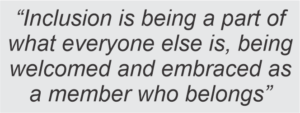All children with disabilities are to be educated to
|
What is Inclusion?
Inclusion is part of a much larger picture than just placement in the regular class within school. It is being included in life and participating using one’s abilities in day-to-day activities as a member of the community.
 It is being a part of what everyone else is, and being welcomed and embraced as a member who belongs. Inclusion can occur in schools, churches, playgrounds, work, and in recreation.
It is being a part of what everyone else is, and being welcomed and embraced as a member who belongs. Inclusion can occur in schools, churches, playgrounds, work, and in recreation.
Human beings, regardless if they happen to have a disability or not, have basic needs that must be met in order to feel fulfilled. The basic needs of food, water, and shelter are necessary for us to exist. It’s also easy to see that when you don’t eat right or exercise it can adversely affect your health and capacity to function in other areas of your life. Having meaning and purpose to what you do and who you are, provides inspiration. Feeling useless or doing things that are meaningless, decreases motivation and self-esteem. A sense of belonging, being loved, having relationships and friendships with others enriches our lives. Feelings of loneliness and alienation can have a negative impact in all areas of our lives. Education helps meet the need to learn and grow and not remain stagnant, but as with any of our needs, if we focus on one at the expense of the others it does not maximize the overall quality of life. When all these needs are met in an integrated way, each area adds strength in the ability to achieve fulfillment in the other areas. Inclusion is about meeting all those needs and maximizing a person’s overall quality of life.

In school, inclusion does not occur by placement in the regular class alone, rather it is a desired end-state. It must be created with proper planning, preparation, and supports. The goal of inclusion is achieved only when a child is participating in the activities of the class, as a member who belongs, with the supports and services they need. Inclusion is “not” a trade-off of supports and services for placement in the regular class and is not a trade-off of achievement of individual goals. No matter where a child with a disability is placed, an Individualized Education Plan (IEP) must be developed around the child’s needs. The IEP objectives must continue to be met in the regular class. The same applies to the related services a child needs, they must continue to be provided for in regular settings.
The fundamental principle of inclusive education is the valuing of diversity within the human community…. When inclusive education is fully embraced, we abandon the idea that children have to become “normal” in order to contribute to the world…. We begin to look beyond typical ways of becoming valued members of the community, and in doing so, begin to realize the achievable goal of providing all children with an authentic sense of belonging. (Kunc 1992, pp. 38-39).
Inclusion in school requires a shift in the paradigm, instead of getting the child ready for the regular class, the regular class gets ready for the child. It’s not a decision of zero or one hundred percent, but whatever balance that can be achieved to maximize meeting all of a child’s needs. The regular class is not looked at as how it is, but how it “can be”.
Adaptations are made to the materials, the curriculum and/or the expectations of the activities for the individual child, maintaining achievement of all individual and academic goals. The purpose isn’t simply social or academic, but to meet all of a child’s needs together where ever possible.
Through inclusive education children with disabilities remain on a path that leads to adult lives as participating members of society. Meeting all their needs together increases their ability to achieve academic and physical growth to their potential, and it enhances their overall quality of life. Inclusive education teaches all children teamwork and how to interrelate and function together with others of different abilities. They learn to value diversity, see the ability of others to contribute, and it gives children a sense of unity.
Material Copyrighted 1996 Kids Together, Inc.
See additional Inclusive Ed pages on Kids Together
- INCLUSIVE EDUCATION
You can also use the <Previous Page – Next Page > links
Located at the bottom of each page to navigate
Additional resources
An Inclusion Story
The story of Sally and Regina, the Smith twins. It highlights how inclusion gives children with disabilities the best chance.
What happens to kids with disabilities in school lockdowns?
Parents worried about their disabled children in emergencies can talk to their school about independent emergency and lockdown plans (IELPs), which piggyback on IEPs. They can discuss how the school plans to help their children in emergencies.
Debunking Myths about Inclusive Education for Students with the Most Significant Cognitive Disabilities (7 page pdf)
There are many myths about including students with the most significant cognitive disabilities in general education classrooms. This Brief debunks six of them:.
